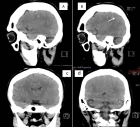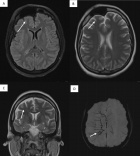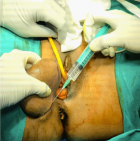Abstract
Case Report
Update in the Understanding, Diagnosis, and Management of Sturge Weber Syndrome: Case Report
Mariana Catalina Garcini Sandoval*, Enrique Espinosa Zúñiga and Martha Guadalupe García Toribio
Published: 24 August, 2023 | Volume 7 - Issue 2 | Pages: 061-064
Sturge-Weber Syndrome (SWS) is a congenital, vascular, neurocutaneous, uncommon disease associated with facial angiomas port wine birthmark (PWB) or “nevus flammeus”, cerebral vascularity alterations (leptomeningeal vascular malformation), and ocular disorders. It is the third most common neurocutaneous syndrome after neurofibromatosis and tuberous sclerosis. GNAQ R183Q is the most frequent related mutation, caused by a postzygotic, somatic, gain-of-function. 75% of patients present seizures during the first year of life, mainly focal motor seizures, with or without consciousness impairment.
We present the case of a 33-year-old female with a diagnosis of SWS, with refractory seizures that started at 4 months of age. In this admission, she presented upper and lower respiratory tract infections that culminated in a convulsive status epilepticus (CSE), the reason for which she required sedation and advanced airway management with adjustment of the anti-seizure medication (ASM). An electroencephalogram (EEG) was performed that reported epileptic activity, as well as an imaging study with data suggestive of calcification in the frontal and right parietal region, compatible with vascular malformation.
Read Full Article HTML DOI: 10.29328/journal.jnnd.1001080 Cite this Article Read Full Article PDF
Keywords:
Sturge-Weber syndrome; Epilepsy; Encephalotrigeminal angiomatosis; Port wine birthmark; Nevus flammeus; Neurocutaneous disease; Phakomatoses; Status epilepticus
References
- Singh AK, Keenaghan M. Sturge-Weber Syndrome. StatPearls. 2023. https://www.ncbi.nlm.nih.gov/books/NBK459163/
- Zeka N, Zeka B, Gerguri A, Bejiqi R, Retkoceri R, Maloku A, Zogaj L. Sturge-Weber syndrome and variability of clinical presentation. Med J Malaysia. 2023 Mar;78(2):145-148. PMID: 36988522.
- Comi A. Current Therapeutic Options in Sturge-Weber Syndrome. Semin Pediatr Neurol. 2015 Dec;22(4):295-301. doi: 10.1016/j.spen.2015.10.005. Epub 2015 Nov 11. PMID: 26706016; PMCID: PMC4943027.
- Comi AM, Sahin M, Hammill A, Kaplan EH, Juhász C, North P, Ball KL, Levin AV, Cohen B, Morris J, Lo W, Roach ES; 2015 Sturge-Weber Syndrome Research Workshop. Leveraging a Sturge-Weber Gene Discovery: An Agenda for Future Research. Pediatr Neurol. 2016 May;58:12-24. doi: 10.1016/j.pediatrneurol.2015.11.009. Epub 2016 Mar 16. PMID: 27268758; PMCID: PMC5509161.
- Vellieux G, Frazzini V, Pichit P, Dupont S, Gourfinkel-An I, Navarro V. A review of the natural history of Sturge-Weber syndrome through adulthood. J Neurol. 2022 Sep;269(9):4872-4883. doi: 10.1007/s00415-022-11132-9. Epub 2022 May 5. PMID: 35508811.
- De la Torre AJ, Luat AF, Juhász C, Ho ML, Argersinger DP, Cavuoto KM, Enriquez-Algeciras M, Tikkanen S, North P, Burkhart CN, Chugani HT, Ball KL, Pinto AL, Loeb JA. A Multidisciplinary Consensus for Clinical Care and Research Needs for Sturge-Weber Syndrome. Pediatr Neurol. 2018 Jul;84:11-20. doi: 10.1016/j.pediatrneurol.2018.04.005. Epub 2018 Apr 18. PMID: 29803545; PMCID: PMC6317878.
- Lo W, Marchuk DA, Ball KL, Juhász C, Jordan LC, Ewen JB, Comi A; Brain Vascular Malformation Consortium National Sturge-Weber Syndrome Workgroup. Updates and future horizons on the understanding, diagnosis, and treatment of Sturge-Weber syndrome brain involvement. Dev Med Child Neurol. 2012 Mar;54(3):214-23. doi: 10.1111/j.1469-8749.2011.04169.x. Epub 2011 Dec 23. Erratum in: Dev Med Child Neurol. 2012 Oct;54(10):957. multiple investigator names added. PMID: 22191476; PMCID: PMC3805257.
- Luat, A. F., Juhász, C., Loeb, J. A., Chugani, H. T., Falchek, S. J., Jain, B., … Pinto, A. (2019). Neurological Complications of Sturge-Weber Syndrome: Current Status and Unmet Needs. Pediatric Neurology, 98, 31–38. https://doi.org/10.1016/j.pediatrneurol.2019.05.013
- Yeom S, Comi AM. Updates on Sturge-Weber Syndrome. Stroke. 2022 Dec;53(12):3769-3779. doi: 10.1161/STROKEAHA.122.038585. Epub 2022 Oct 20. PMID: 36263782.
- Sánchez-Espino LF, Ivars M, Antoñanzas J, Baselga E. Sturge-Weber Syndrome: A Review of Pathophysiology, Genetics, Clinical Features, and Current Management Approache. Appl Clin Genet. 2023 Apr 24;16:63-81. doi: 10.2147/TACG.S363685. PMID: 37124240; PMCID: PMC10145477.
- Desai S, Glasier C. Sturge–Weber Syndrome. 2017. 377(9): e11. https://doi.org/10.1056/NEJMICM1700538
- Comi AM, McCann M, Singh P, Pevsner J. Sturge-Weber syndrome. In Rosenberg’s Molecular and Genetic Basis of Neurological and Psychiatric Disease. 2020; 2: 213–223. https://doi.org/10.1016/B978-0-12-813866-3.00014-X
- Pinto AL, Chen L, Friedman R, Grant PE, Poduri A, Takeoka M, Prabhu SP, Sahin M. Sturge-Weber Syndrome: Brain Magnetic Resonance Imaging and Neuropathology Findings. Pediatr Neurol. 2016 May;58:25-30. doi: 10.1016/j.pediatrneurol.2015.11.005. Epub 2015 Nov 26. PMID: 26706049.
- Roach ES. Neurocutaneous syndromes. Pediatr Clin North Am. 1992 Aug;39(4):591-620. doi: 10.1016/s0031-3955(16)38367-5. PMID: 1635798.
- Yan H, Hu M, Cui Y, Li L, Liang T. Clinical characteristics of infants with port-wine stain and glaucoma secondary to Sturge-Weber Syndrome. BMC Ophthalmol. 2022 Jun 9;22(1):260. doi: 10.1186/s12886-022-02476-x. PMID: 35681114; PMCID: PMC9185922.
- Kwan P, Arzimanoglou A, Berg AT, Brodie MJ, Allen Hauser W, Mathern G, Moshé SL, Perucca E, Wiebe S, French J. Definition of drug resistant epilepsy: consensus proposal by the ad hoc Task Force of the ILAE Commission on Therapeutic Strategies. Epilepsia. 2010 Jun;51(6):1069-77. doi: 10.1111/j.1528-1167.2009.02397.x. Epub 2009 Nov 3. Erratum in: Epilepsia. 2010 Sep;51(9):1922. PMID: 19889013.
- Betjemann JP, Lowenstein DH. Status epilepticus in adults. Lancet Neurol. 2015 Jun;14(6):615-24. doi: 10.1016/S1474-4422(15)00042-3. Epub 2015 Apr 20. PMID: 25908090.
- Powell S, Fosi T, Sloneem J, Hawkins C, Richardson H, Aylett S. Neurological presentations and cognitive outcome in Sturge-Weber syndrome. Eur J Paediatr Neurol. 2021 Sep;34:21-32. doi: 10.1016/j.ejpn.2021.07.005. Epub 2021 Jul 9. PMID: 34293629.
Figures:

Figure 1

Figure 2

Figure 3

Figure 4
Similar Articles
-
Epilepsy due to Neurocysticercosis: Analysis of a Hospital CohortOlivier Mukuku*,Marcellin Bugeme,Adjratou Djeynabou Sow,Athanase Millogo,Oscar Numbi Luboya,Kamadore Touré. Epilepsy due to Neurocysticercosis: Analysis of a Hospital Cohort. . 2020 doi: 10.29328/journal.jnnd.1001036; 4: 063-068
-
Nutritional interventions for the prevention and treatment of neurological disorders such as anxiety, bipolar disorder, depression, epilepsy, multiple sclerosis, and schizophreniaSahithi Madireddy*,Samskruthi Madireddy. Nutritional interventions for the prevention and treatment of neurological disorders such as anxiety, bipolar disorder, depression, epilepsy, multiple sclerosis, and schizophrenia. . 2022 doi: 10.29328/journal.jnnd.1001070; 6: 052-071
-
Update in the Understanding, Diagnosis, and Management of Sturge Weber Syndrome: Case ReportMariana Catalina Garcini Sandoval*, Enrique Espinosa Zúñiga, Martha Guadalupe García Toribio. Update in the Understanding, Diagnosis, and Management of Sturge Weber Syndrome: Case Report. . 2023 doi: 10.29328/journal.jnnd.1001080; 7: 061-064
-
Pyridostigmine-Induced Status Epilepticus Rat Model Was Resistant to Increasing Doses of Ramipril: The Latter Triggered Epileptogenesis, Arrhythmia, and Cardiac Ischemia in a Dose-Dependent MannerSherine Abdelmissih*,Monica Gamal,Kerollos M Naeem. Pyridostigmine-Induced Status Epilepticus Rat Model Was Resistant to Increasing Doses of Ramipril: The Latter Triggered Epileptogenesis, Arrhythmia, and Cardiac Ischemia in a Dose-Dependent Manner. . 2025 doi: 10.29328/journal.jnnd.1001106; 9: 010-027
Recently Viewed
-
Agriculture High-Quality Development and NutritionZhongsheng Guo*. Agriculture High-Quality Development and Nutrition. Arch Food Nutr Sci. 2024: doi: 10.29328/journal.afns.1001060; 8: 038-040
-
A Low-cost High-throughput Targeted Sequencing for the Accurate Detection of Respiratory Tract PathogenChangyan Ju, Chengbosen Zhou, Zhezhi Deng, Jingwei Gao, Weizhao Jiang, Hanbing Zeng, Haiwei Huang, Yongxiang Duan, David X Deng*. A Low-cost High-throughput Targeted Sequencing for the Accurate Detection of Respiratory Tract Pathogen. Int J Clin Virol. 2024: doi: 10.29328/journal.ijcv.1001056; 8: 001-007
-
A Comparative Study of Metoprolol and Amlodipine on Mortality, Disability and Complication in Acute StrokeJayantee Kalita*,Dhiraj Kumar,Nagendra B Gutti,Sandeep K Gupta,Anadi Mishra,Vivek Singh. A Comparative Study of Metoprolol and Amlodipine on Mortality, Disability and Complication in Acute Stroke. J Neurosci Neurol Disord. 2025: doi: 10.29328/journal.jnnd.1001108; 9: 039-045
-
Development of qualitative GC MS method for simultaneous identification of PM-CCM a modified illicit drugs preparation and its modern-day application in drug-facilitated crimesBhagat Singh*,Satish R Nailkar,Chetansen A Bhadkambekar,Suneel Prajapati,Sukhminder Kaur. Development of qualitative GC MS method for simultaneous identification of PM-CCM a modified illicit drugs preparation and its modern-day application in drug-facilitated crimes. J Forensic Sci Res. 2023: doi: 10.29328/journal.jfsr.1001043; 7: 004-010
-
A Gateway to Metal Resistance: Bacterial Response to Heavy Metal Toxicity in the Biological EnvironmentLoai Aljerf*,Nuha AlMasri. A Gateway to Metal Resistance: Bacterial Response to Heavy Metal Toxicity in the Biological Environment. Ann Adv Chem. 2018: doi: 10.29328/journal.aac.1001012; 2: 032-044
Most Viewed
-
Evaluation of Biostimulants Based on Recovered Protein Hydrolysates from Animal By-products as Plant Growth EnhancersH Pérez-Aguilar*, M Lacruz-Asaro, F Arán-Ais. Evaluation of Biostimulants Based on Recovered Protein Hydrolysates from Animal By-products as Plant Growth Enhancers. J Plant Sci Phytopathol. 2023 doi: 10.29328/journal.jpsp.1001104; 7: 042-047
-
Sinonasal Myxoma Extending into the Orbit in a 4-Year Old: A Case PresentationJulian A Purrinos*, Ramzi Younis. Sinonasal Myxoma Extending into the Orbit in a 4-Year Old: A Case Presentation. Arch Case Rep. 2024 doi: 10.29328/journal.acr.1001099; 8: 075-077
-
Feasibility study of magnetic sensing for detecting single-neuron action potentialsDenis Tonini,Kai Wu,Renata Saha,Jian-Ping Wang*. Feasibility study of magnetic sensing for detecting single-neuron action potentials. Ann Biomed Sci Eng. 2022 doi: 10.29328/journal.abse.1001018; 6: 019-029
-
Pediatric Dysgerminoma: Unveiling a Rare Ovarian TumorFaten Limaiem*, Khalil Saffar, Ahmed Halouani. Pediatric Dysgerminoma: Unveiling a Rare Ovarian Tumor. Arch Case Rep. 2024 doi: 10.29328/journal.acr.1001087; 8: 010-013
-
Physical activity can change the physiological and psychological circumstances during COVID-19 pandemic: A narrative reviewKhashayar Maroufi*. Physical activity can change the physiological and psychological circumstances during COVID-19 pandemic: A narrative review. J Sports Med Ther. 2021 doi: 10.29328/journal.jsmt.1001051; 6: 001-007

HSPI: We're glad you're here. Please click "create a new Query" if you are a new visitor to our website and need further information from us.
If you are already a member of our network and need to keep track of any developments regarding a question you have already submitted, click "take me to my Query."
















































































































































